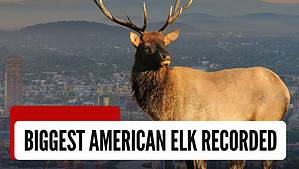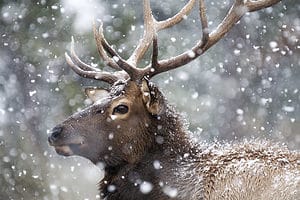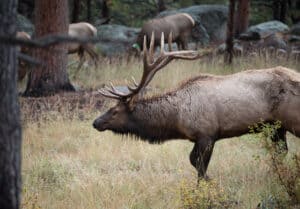While elk and caribou share many similarities there are several differences between these two mammals. Elk and caribou are both members of the deer family and are herbivores. However, an adult elk is taller and weighs more than an adult caribou. Caribou is also the only species in the deer family where both male and female grow antlers, whereas female elk do not grow antlers.
Both mammals have dense coats of fur that help them withstand cold temperatures. Caribou are found in boreal forests and on the Arctic tundra. The nose of caribous are covered in short coat of hair to keep the air that they inhale comparatively warm. Alternatively, elk live in forests and meadows in North America, eastern Asia, and have now been introduced to various other mountainous regions across the globe, namely in Australia, New Zealand and Argentina.
Elks are very social animals and live in very large groups. When it comes to mating, both elk and caribou males fight for dominance by locking horns and fighting, posturing, and by bugling which is making loud noise to scare the opponent. Adult male elks also dig holes, urinate in it and then roll around in the hole, apparently the smell attracts female elks. A dominant caribou male can impregnate 15 to 20 females in one season. Caribou males also lose most of its reserved weight during the mating season as they stop eating. Both animals are seasonal migrators, and some caribou are known to be the longest migrating terrestrial mammal and may travel up to 5000 kms in one season.
Check out some more information about the significant differences between these two members of the Cervidae family!
The 8 Key Differences Between Caribou and Elk
To truly compare and contrast these two animals, here are a few of the key differences that separate them.
Caribou vs Elk: Size
An adult elk is taller and weighs more than an adult caribou. Specifically, an adult elk can grow to a height ranging from 56 to 68 inches from its hooves to its withers. Alternatively, a caribou measures from 34 to 62 inches tall. In terms of weight, an adult male elk ranges from 325 to 1100 pounds while an adult male caribou weighs from 350 to 400 pounds.
Female elks, also known as cows, are much smaller in size varying between 500 to 600 pounds and stand up to 45 inches in height. While the female caribou weighs between 175 to 225 pounds and 33 inches in height.
Caribou vs Elk: Lifespan
The lifespan of these two mammals accounts for another difference between them. Normally, elk don’t live as long as caribou. The lifespan of an elk is 8 to 12 years whereas a caribou’s lifespan ranges from 12 to 15 years.
During their lifespans, both species rely on herds for help locating food, protection, and other support. Elk and caribou are sometimes known to migrate during the winter months. Both types of animal give birth to one calf at a time about once per year.
Caribou vs Elk: Habitat
Another difference between these two animals has to do with habitat. Many caribou live on the Arctic tundra. They have an undercoat with a wooly texture along with an upper coat that repels moisture that helps to keep them warm. Also, a caribou’s hooves are broad and flat allowing them to keep their balance while walking across snow and ice.
Elk live in forests, meadows, and sometimes near swampy areas. Their narrow, cloven hooves help them to walk on the soft, moist ground of their woodland habitat.
Caribou vs Elk: Species
Though elk and caribou belong to the same Cervidae family, they are different species. The scientific name of an elk is Cervus canadensis. The scientific name of a caribou is Rangifer tarandus.
There are seven subspecies of caribou. These include:
- Barren-ground caribou (Rangifer tarandus granti)
- Svalbard caribou (R.t platyrhynchus)
- European caribou (R.t. tarandus)
- Finnish forest reindeer (R.t. fennicus)
- Greenland caribou (R.t. groenlandicus)
- Woodland caribou (R.t. caribou)
- Peary caribou (R.t. pearyi)
The six subspecies of elk in North America include:
- Roosevelt’s elk (C. c. roosevelti)
- Tule elk (C. c. nannodes)
- Manitoban elk (C. c. manitobensis)
- Rocky Mountain elk (C. c. nelsoni)
- Eastern elk (C. c. canadensis; extinct)
- Merriam’s elk (C. c. merriami; extinct)
Caribou vs Elk: Coat
Caribou and elk have different colored fur. In fact, the fur coat of each animal changes color depending on the season of the year.
Elk can have a gray or even a white coat in the wintertime. When the season changes, an elk sheds its winter coat and takes on reddish-brown fur for the spring and summer.
A caribou’s coat can be silvery-white or light brown during the winter season. The color varies with different types of caribou. In the summertime, a caribou’s coat turns light to dark brown.
Caribou vs Elk: Antlers
In terms of size, a caribou’s antlers are larger than an elk’s antlers. There’s also a difference in shape. Caribou have C-shaped antlers whereas elk have long, tall antlers featuring several points. Caribous also have the largest antlers among all deer species. The adult male caribou sheds their antlers in December, young ones in spring and the females shed in summer. Elks shed their antlers in March and regrow them in the month of May.
Caribou vs Elk: Sounds
Most animals have some ways to communicate with one another. Caribou and elk both communicate but with different sounds. An elk is known for its bugling sounds during the breeding season. This sound is high-pitched and has been compared to a whistling howl. Alternatively, a caribou uses grunts to communicate with the members of its herd.
Caribou vs Elk: Hoof Shape
Caribou are able to survive on the Arctic tundra due to several adaptations. One of those adaptations involves their hooves. They are broad and flat which allows them to step across the slippery ground without losing their balance and falling.
An elk’s hooves are narrower in design and cloven so they can walk on the moist grass, mud, or dry ground in their forest habitat.
Summary
Here is a summary of our finds
| Points of Difference | Caribou | Elk |
|---|---|---|
| Size | 350 lbs. – 400 lbs. | 650 lbs. – 850 lbs. |
| Lifespan | 12 to 15 years | 8 to 12 years |
| Habitat | Boreal forests and on the Arctic tundra. They live in North America, Greenland, Asia, and Europe. | Forests and meadows in North America, Argentina, New Zealand, Australia, and eastern Asia |
| Species | Rangifer tarandus They are known as reindeer in Europe, and there are seven subspecies of caribou. | Cervus canadensis They are sometimes called wapiti, and there are six subspecies of elk in North America. |
| Coat color | Larger species have a light to dark brown coat while smaller species can have white fur. | Their coat can be red or gray paired with an area of white hair on their rump. |
| Antlers | Male and female caribou have antlers; their antlers are C-shaped. | Only male elk have antlers. They are long and tall antlers with several points. |
| Sounds | Grunting | Bugling/Whistling |
| Hoof shape | Broad-shaped, cloven hooves with hair. | Crescent-shaped, narrow, cloven. |
Is the Caribou the Same Animal as a Reindeer?
Yes. The reindeer is just a domesticated caribou. The closest relatives of the caribou/reindeer are the pygmy deer and the white-tailed deer.
Consider, though, that the reindeer has been domesticated for thousands of years — all the way back to the Bronze and Iron Ages. It has been bred to be a pack animal or for meat and pelts. Throughout most of the world, the animal is known as a reindeer; it is only in North America that we make a distinction between the wild and the domesticated and call them caribou and reindeer.
The reindeer is one of the oldest animals in hunting lore and can be seen depicted in cave paintings. It is economically important to this day for many circumpolar peoples.
The photo featured at the top of this post is ©
FAQs (Frequently Asked Questions)
Are elk and caribou the same thing?
No. Though these animals belong to the Cervidae family, they’re different species. Some basic differences include their size, habitat, hooves, lifespan, and the ways they communicate.
Can a caribou and elk mate?
Though there have been stories of hybrid caribou/elk wandering around in the woods, this is very unlikely to be true. After all, they are different species.
Thank you for reading! Have some feedback for us? Contact the AZ Animals editorial team.






